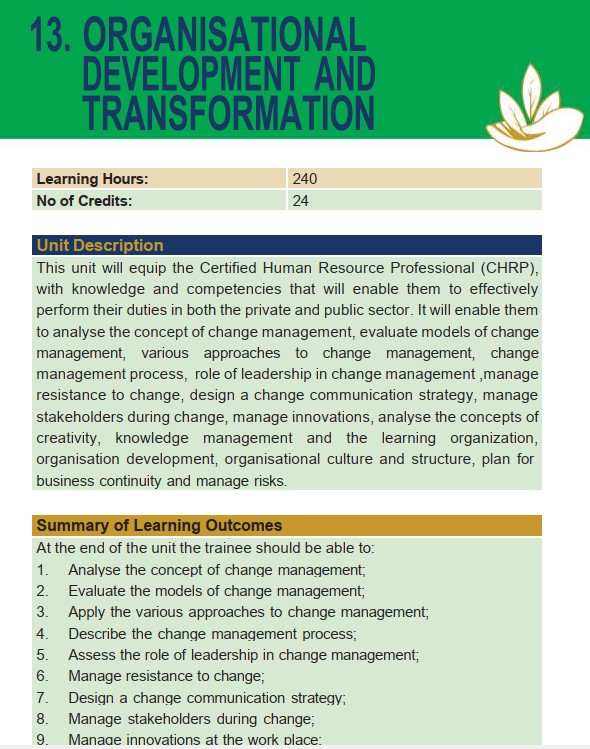
Topics
1. Introduction to Change Management
1.1 The concept of change management
1.2 The need for change management
1.3 The forces of change
1.4 Change management principles
1.5 Change symbolism
1.6 Types of change
1.7 Scope of change
1.8 Characteristics of change
1.9 Benefits of successful change management
2. Models of Change Management
2.1 Dice Model
2.2 ADKAR
2.3 Kotters eight step model of transformational change
2.4 McKinsiey Model
2.5 Kurt- Lewin Schein Model
3. Approaches to Change Management
3.1 Empirical – Rational
3.2 Normative – Reductive
3.3 Power – Coercive
3.4 Incremental – Adaptive
4. Change Management Process
4.1 Need for change
4.2 Plan change
4.3 Develop change program
4.4 Implement change
4.5 Review change
4.6 Anchor change in the organizational culture
4.7 Transition in change management
5. The role of Leadership in Change Management
5.1 Initiating Change
5.2 Sponsorship
5.3 Role model
5.4 Decision making
5.5 Communication
5.6 Responsibility and accountability
5.7 Building coalition
5.8 Leading the process
5.9 Establishment of change management team
5.10 Building resilience and change hardiness
6. Managing Resistance to Change
6.1 Diagnosing resistance to change
6.2 Reasons for resistance
6.3 Types of resistance
6.4 Challenges in reducing resistance
6.5 Techniques for overcoming resistance to change
6.6 The role of HR in managing resistance to change
7. Change Communication Strategy
7.1 Introduction to change communication strategy
7.2 Objectives of change communication
7.3 Principles of change communication
7.4 The change communication model
7.5 Measuring communication effectiveness
7.6 The value of effective change communication
7.7 The communication strategy and plan
8. Stakeholder Management in Change Management
8.1 Introduction to stakeholder management
8.2 Benefits of stakeholders management during change
8.3 Stakeholder mapping
8.4 Stakeholder analysis
8.5 Strategies for managing stakeholders during change
9. Innovation Management
9.1 Introduction to innovation
9.2 Concept of innovation
9.3 Types of innovation
9.4 The characteristics of an innovative work environment
9.5 Innovation process
9.6 Importance of innovation
9.7 Innovation in the HR practice
9.8 Role of change sponsor in innovation
9.9 Actions and approaches to innovation
9.10 Innovation techniques
9.11 Value analysis, components and process
10. Creativity
10.1 Concept and types of creativity
10.2 Creative thinking
10.3 Arguments for creativity
10.4 Barriers to creativity
10.5 Components of creativity
10.6 Creative process
10.7 Sources of new ideas
10.8 Turning creative ideas into opportunities
10.9 Creative problem-solving techniques
10.10 Creativity in human resource management practice
10.11 Importance of creativity in decision making
11. Knowledge Management and the Learning Organization
11.1 Introduction to knowledge management
11.2 Data, information and knowledge
11.3 Elements of successful knowledge management
11.4 Knowledge management strategies
11.5 Challenges of knowledge management
11.6 The role of managers in implementing knowledge management and learning
11.7 The learning organisation
11.8 Components of learning organization
11.9 Distinction between learning organisation and organisation learning
12. Organization Development
12.1 Introduction to organization development
12.2 History of organization development
12.3 Models and theories of organization development
12.4 Features of organisation development
12.5 Objectives of organisational development
12.6 Organisational development climate
12.7 Organisational development strategy
12.8 Organisation development interventions
12.9 Process of organisation development interventions
12.10 Revolutionary values and believes of organization development
12.11 Second – Generation organisation development
12.12 Power, politics and ethics in organisation development
12.13 Future of organisation development
12.14 Organisational transformation
13. Organisational Culture and Sstructure
13.1 Introduction to organisational culture
13.2 Characteristics of organisational culture
13.3 Assessing the culture of the organization
13.4 Understanding the culture of your organisation
13.5 Components of organisational culture
13.6 Factors that shape an organization’s culture
13.7 Benefits of corporate culture
13.8 Impact of organisational culture in change management
13.9 The role of HR in maintaining effective corporate culture
13.10 Organisational culture and culture change
13.11 Impact of organisational structure in change management
13.12 Meaning of organisational structure
13.13 Types of organisational structures
13.14 Effect of organisational structure in change management
14. Business Continuity Planning and Risk Management
14.1 Introduction to business continuity planning and risk management
14.2 Objectives of business continuity planning and risk management
14.3 Types of organisational risks
14.4 Risk assessment process
14.5 Principles of risk management
14.6 Risk management methodology
14.7 Risk register
14.8 Responsibility for risk management and risk governance
14.9 Concept of business continuity planning
14.10 Elements of business continuity planning
14.11 Principles of business continuity planning
14.12 Business continuity planning process
14.13 The business continuity plan
14.14 Human resource risks
14.15 Role of HR in risk management
